Looked after children: education outcomes 2018-2019
Information on attainment and destinations of school leavers, school attendance and absence, and achievement of curriculum for excellence levels for looked after children in Scotland.
Educational attainment
- Attainment for school leavers who were looked after within the last year has improved over the last six years.
- Looked after leavers who were in foster care or with friends or relatives had higher attainment than other placement types
This section presents data on the educational attainment of the estimated 1,031 young people who were looked after during the period 1 August 2018 to 31 July 2019 who left school during 2018/19.
Age of school leavers
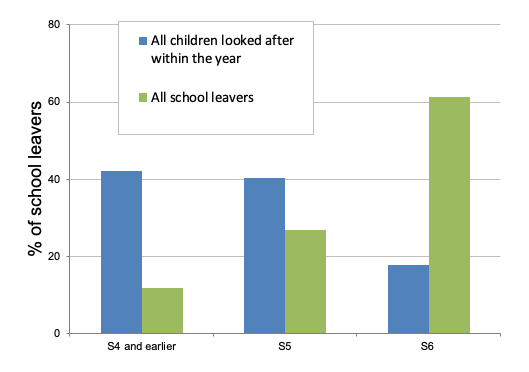
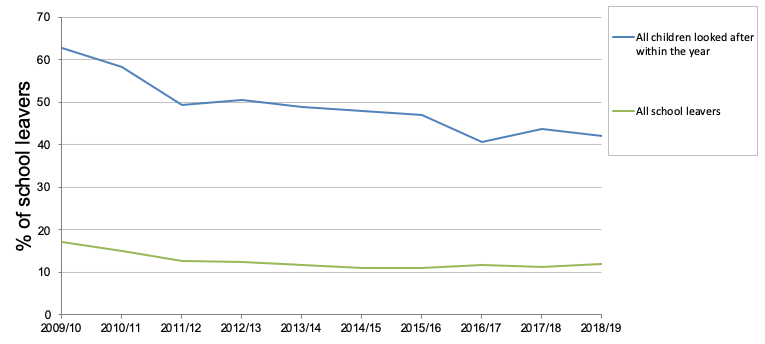
Looked after children tend to leave school at earlier stages, as shown in Chart 1a. In 2018/19 42% of school leavers who were looked after within the year left school in S4 or earlier, compared with 12% of school leavers more generally. The proportion of looked after leavers who left school in S4 or earlier has decreased since 2012/13, however the proportion remains higher than for all school leavers (Chart 1b).
Highest level of qualification
The Scottish Credit and Qualifications Framework (SCQF) is used as the basis for reporting attainment. The SCQF is Scotland's national qualifications framework. The SCQF has 12 levels, which, in ascending order (SCQF Level 1-12), indicate the level of difficulty of a particular qualification. With reference to a set of 'level descriptors', the SCQF allows for broad comparisons to be made between qualifications (Illustration 2). It also allows learners, employers and the public in general, to understand the range of skills and learning that should be achieved at each level.
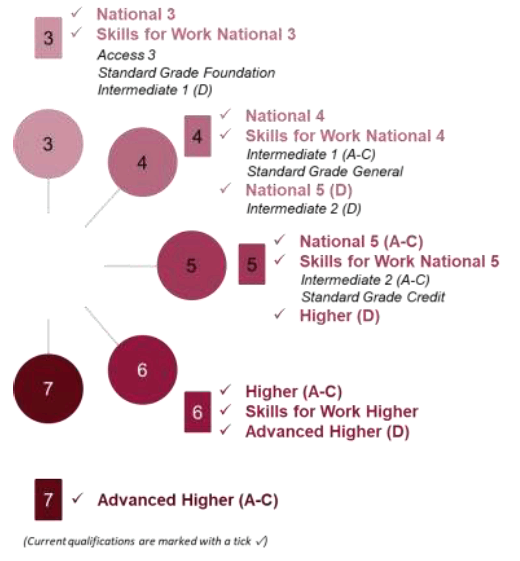
Highers (SCQF Level 6) are generally taken in S5/S6 and Advanced Highers (SCQF 7) are generally taken in S6. Highers, sometimes along with Advanced Highers, are the Scottish qualifications required for entry into Higher Education.
In this publication, grade A to C (or ungraded pass) is considered a pass. If a pupil attains a D at a certain level, this is counted as attainment at the level below.
School leavers from 2018/19 are the fourth cohort to have experienced the Curriculum for Excellence (CfE) throughout the senior phase of their school education. School leavers from 2013/14 and 2014/15 will have taken a range of qualifications from the current set to older qualifications that have now been phased out.
| School leavers looked after within the last year | All school leavers | |
|---|---|---|
| 1 or more qualification at SCQF level 3 or better | 83 | 98 |
| 1 or more qualification at SCQF level 4 or better | 70 | 96 |
| 1 or more qualification at SCQF level 5 or better | 35 | 85 |
| 1 or more qualification at SCQF level 6 or better | 11 | 61 |
| 1 or more qualification at SCQF level 7 | 2 | 19 |
| No passes at SCQF 3 or better | 17 | 2 |
Almost all school leavers (96%) have at least one qualification at level 4 or better. This compares with 70% of young people looked after within the last year leaving school with the same level of qualifications. At the higher levels of qualification, 61% of all leavers have at least one qualification at level 6 or better, compared with 11% of looked after school leavers.
Chart 2a shows the percentage of school leavers who were looked after within the year who left school with one or more qualifications at each SCQF level and Chart 2b shows the same for all school leavers. The percentage of looked after school leavers achieving all SCQF qualification levels is consistently lower than all school leavers; however, educational attainment among looked after leavers has improved notably over the last ten years, narrowing the gap to all school leavers. However, most of the improvement in attainment for looked after school leavers occurred from around 2011/12 to 2013/14 and the levels of attainment achieved have been broadly stable since then.
The proportion of leavers looked after within the year with no qualifications at SCQF 3 or higher decreased from 25% in 2009/10 to 17% in 2011/12, and has fluctuated around that level since (17% in 2018/19). Attainment at higher levels, however, has increased since 2012/13: from 62% to 70% at SCQF level 4 or better, from 23% to 35% at SCQF level 5 or better, from 4% to 11% at SCQF level 6 or better and a small increase from 1% to 2% at SCQF level 7 or better.
Chart 2: Percentage of all school leavers and those who were looked after, by highest level of attainment achieved, 2009/10 to 2018/19(1)
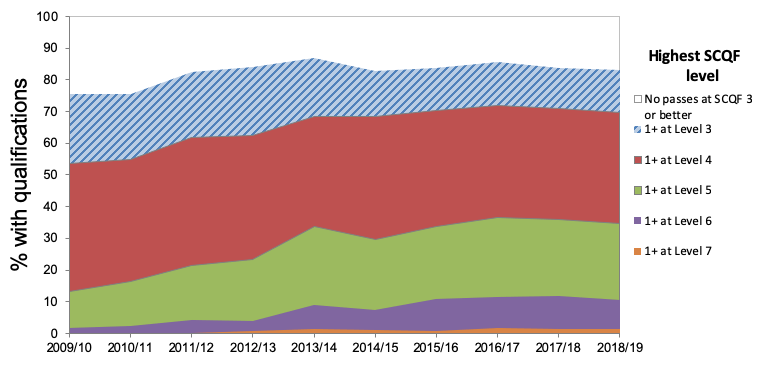
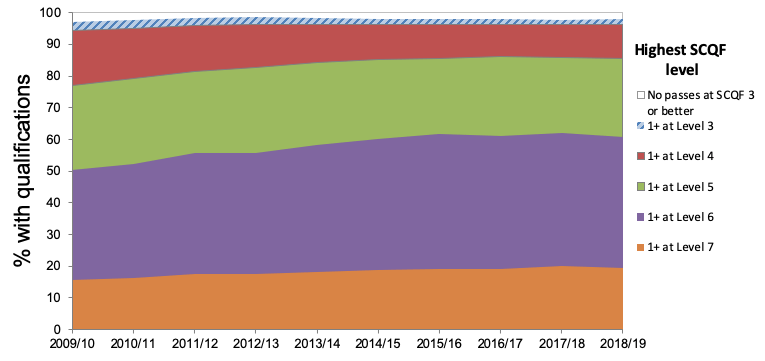
(1) All figures have been revised in 2018/19 to ensure that all years were calculated using the same method.
Type of accommodation
When a young person is looked after, there are various types of care setting where they can be placed. Placements can be at home (where a child is subject to a Supervision Requirement and continues to live in their usual place of residence), foster care, kinship care (where they are living with friends or relatives) or residential care. Table 1.2 presents the attainment level of leavers looked after within the last year by the type of placement.
Educational attainment varies across the types of accommodation in which looked after children are living. School leavers in foster care provided and purchased by the local authority performed better than those in other care settings, with 66% and 70% achieving at least one qualification at SCQF level 5 or better respectively, compared with 35% of all looked after school leavers.
School leavers who were looked after within the last year in 'other residential settings', which includes residential schools, secure care accommodation and crisis care, had the lowest overall levels of attainment, with 59% achieving at least one qualification at SCQF level 3 or better, compared with 83% for all looked after school leavers. School leavers who were looked after at home with parents also had low levels of attainment compared with most other placement types.
| Looked after leavers | ||||||
|---|---|---|---|---|---|---|
| % No passes at SCQF 3 or better | % with 1 or more qualification at SCQF | |||||
| Level 3 or better | Level 4 or better | Level 5 or better | Level 6 or better | Level 7 or better | ||
| In the community (children with one placement) | ||||||
| At home with parents | 27 | 73 | 48 | 13 | * | 0 |
| With friends or relatives | 10 | 90 | 82 | 46 | 15 | 0 |
| With foster carers provided by LA | 5 | 95 | 94 | 66 | 27 | 6 |
| With foster carers purchased by LA | 7 | 93 | 90 | 70 | 29 | * |
| In other community(2) | * | * | * | * | * | * |
| Residential Accommodation (children with one placement) | ||||||
| In local authority home | 22 | 78 | 70 | 27 | 9 | * |
| In voluntary home | 17 | 83 | 67 | * | * | * |
| In other residential(3) | 41 | 59 | 34 | * | 0 | 0 |
| More than one placement | 13 | 87 | 75 | 31 | 4 | * |
| All looked after within the last year | 17 | 83 | 70 | 35 | 11 | 2 |
(1) Cells containing * represent small numbers that have been suppressed to maintain confidentiality.
(2) Includes supported accommodation and with prospective adopters.
(3) Includes in residential school, secure care accommodation and crisis care..
Number of placements in the last year
Young people who are looked after may be looked after in different residences over time. Moving to a new residence or a new carer is recorded as a change in placement. Table 1.3 shows that a slightly higher percentage of leavers looked after within the year with two placements achieved at least one qualification at SCQF level 3 or better (88%) than those with one or three or more placements (both 82%). However, a higher proportion of those with one placement achieved qualifications at higher attainment levels (SCQF level 5 or better).
| Number of placements | No passes at SCQF level 3 or better | 1 or more qualification at SCQF level 3 or better | 1 or more qualification at SCQF level 4 or better | 1 or more qualification at SCQF level 5 or better | 1 or more qualification at SCQF level 6 or better | 1 or more qualification at SCQF level 7 or better |
|---|---|---|---|---|---|---|
| 1 | 18 | 82 | 69 | 35 | 12 | 2 |
| 2 | 12 | 88 | 79 | 31 | 6 | * |
| 3 or more | 18 | 82 | 64 | 30 | 0 | 0 |
| All looked after within the last year | 17 | 83 | 70 | 35 | 11 | 2 |
(1) Cells containing * represent small numbers that have been suppressed to maintain confidentiality.
Contact
Email: children.statistics@gov.scot
There is a problem
Thanks for your feedback